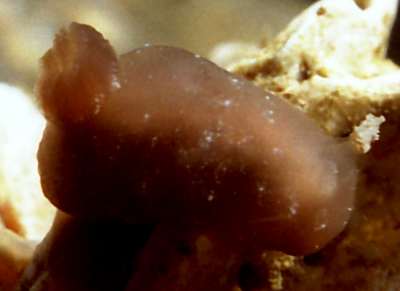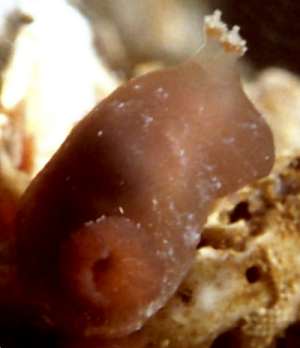Hallaxa iju from nthn New South Wales
December 17, 2003
From: Denis Riek


Dear Bill,
As a first time correspondent, I must begin by congratulating you on a fine achievement, this is the best site in this field!
I live at Brunswick Heads in northern New South Wales [Australia], and am a regular snorkler in the river here. The river is typical of the smaller north coast rivers, shallow sand bottom with a sea break wall and about 1km of internal walls. January, February of this year was the best diving I have ever seen in this river, due undoubtedly to the long drought, and I was able to photograph 35 species of Opisthobranch's. Species such as Chromodoris tinctoria, Noumea simplex, Hypselodoris obscura and Plocamopherus ceylonicus were quite common. The drought in this area broke a few months later and 4 days of fresh water killed nearly everything in the river. It is just now recovering with nudibranch's showing up again.I have not been able to identify the Dorid pictured, is it a Rostanga? The rhinophores are very close together. It was found mid February under a rock on an internal wall in 2 metres, measuring approx 15mm.
I hope the picture is good enough for identification as my equipment is a bit crude!
Regards,
Denis Riek
denisriek@hotmail.com
Riek, D., 2003 (Dec 17) Hallaxa iju from nthn New South Wales. [Message in] Sea Slug Forum. Australian Museum, Sydney. Available from http://www.seaslugforum.net/find/11575Dear Denis,
I'm afraid your story of drought-breaking rain killing off the life in coastal rivers is a common occurrence in New South Wales. Even large harbours like Sydney harbour are not immune to this effect and I can remember some years ago every organism attached to a hard surface in the harbour down to about 2m depth was killed off - and of course all the other associated life. While I appreciate the farmers describing it as 'life-giving' rain, but I am sure if marine life could talk they would describe it rather differently.
Now to your animal. It is a species of Hallaxa, most probably Hallaxa iju. The cup-shaped or goblet-shaped gill circle is quite characteristic of the genus. The way the rhinophores are arranged so close together is I think a developmental abnormality.
Best wishes
Bill Rudman
Related messages
-
Hallaxa iju from Hong Kong
From: Bernard Picton , May 8, 2002
